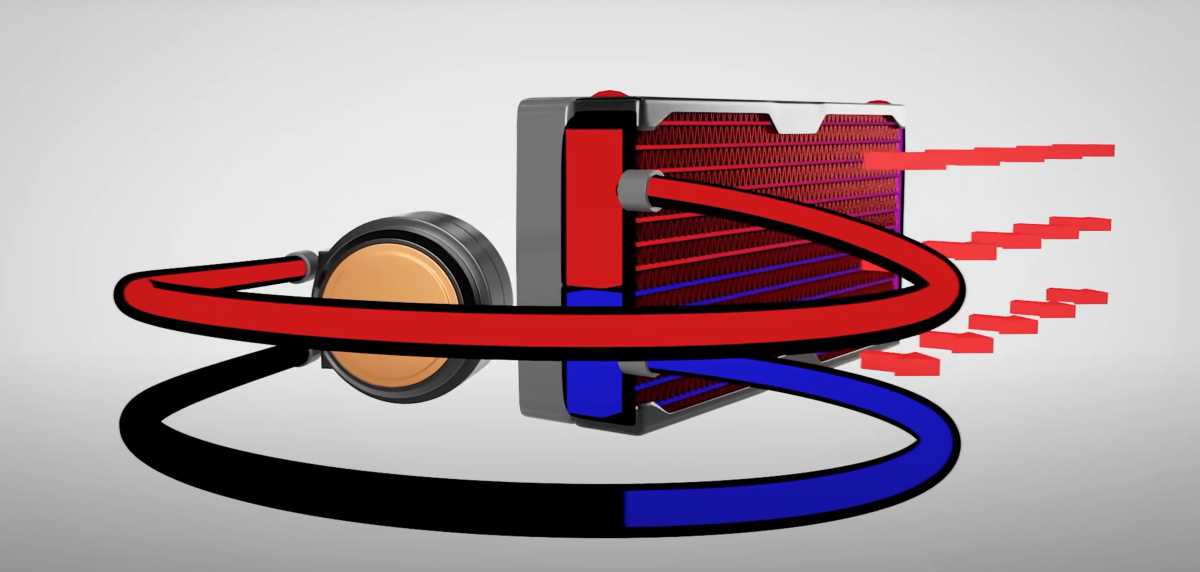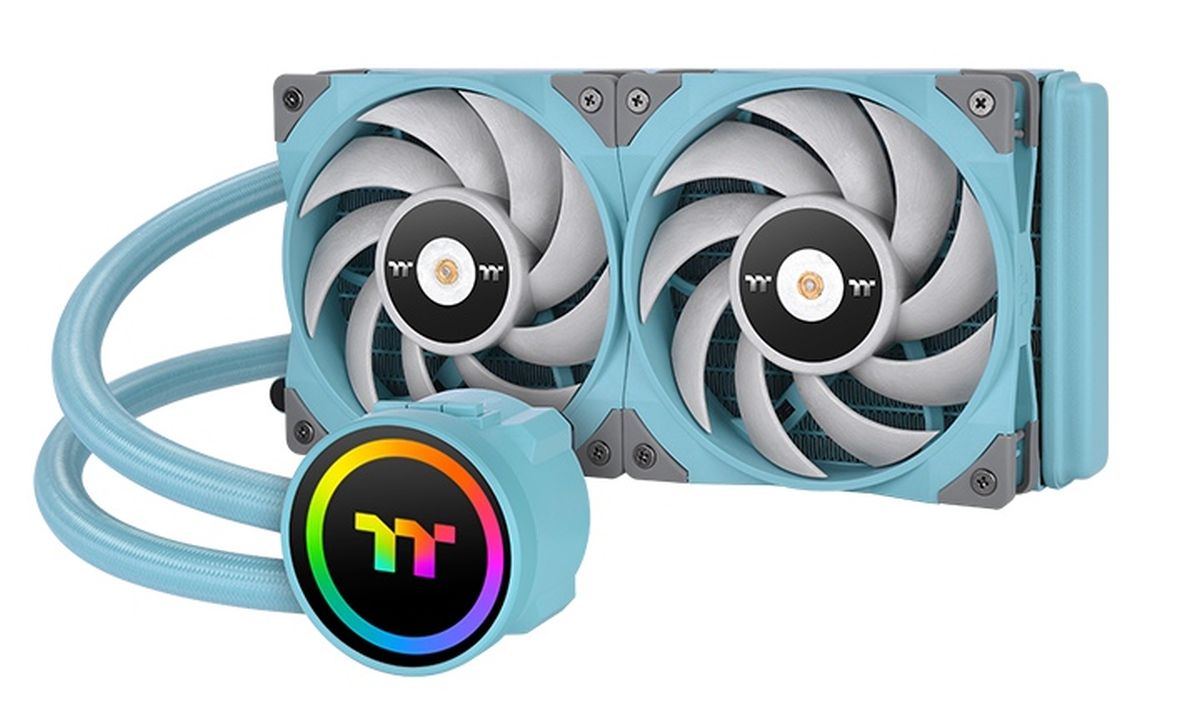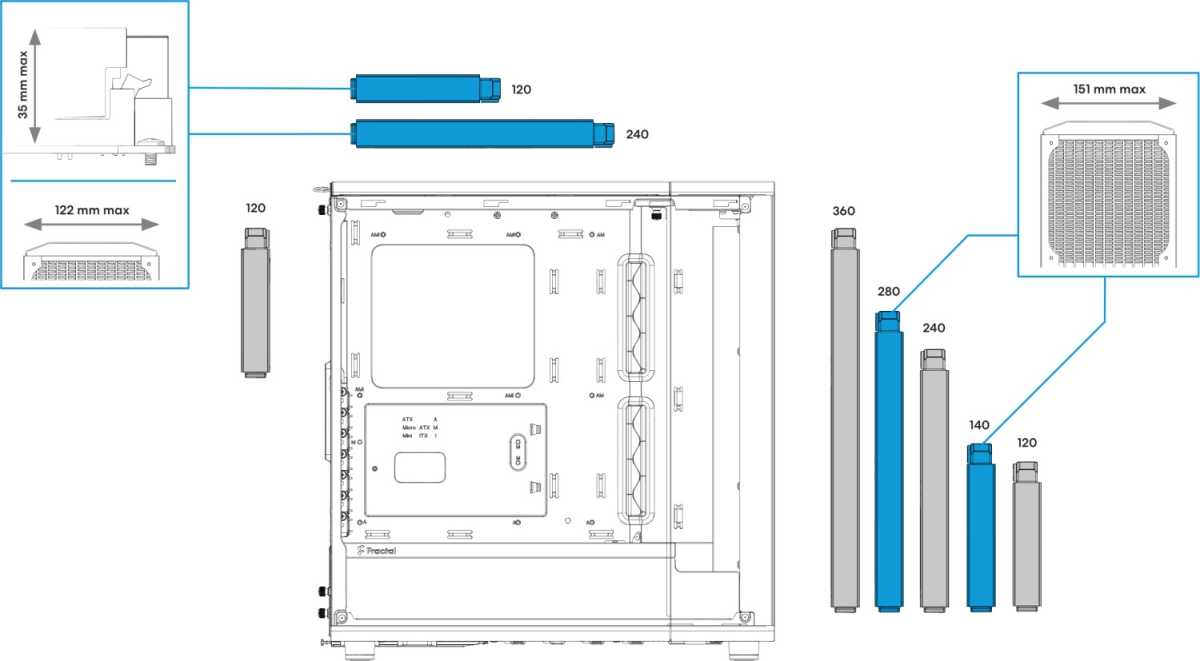All-in-one water-cooling systems are becoming increasingly popular for cooling CPUs. However, compact water cooling systems not only have advantages, but also disadvantages compared to conventional air cooling, which you should be aware of. In addition, there are a few points to consider when selecting and installing them.
Our guide will explain everything you need to know about all-in-one water coolers. Let’s dig in.
All-in-one water cooling: Our purchase recommendations
We do not recommend a 120mm or 140mm water cooler for most purposes, as the cooling capacity is quite limited (approximately 100 watts) and there are better and cheaper alternatives among the air coolers. An exception can be mini PCs in which there is not enough space for air cooling.
| Special features | 240 mm | 280 mm | 360 mm | 420 mm | |
|---|---|---|---|---|---|
| Price-Performance (without RGB) | 6 years warranty, 450mm tube length, 38mm radiator, VRM cooling | Arctic Liquid Freezer II 240 | Arctic Liquid Freezer II 280 | Arctic Liquid Freezer II 360 | Arctic Liquid Freezer II 420 |
| Price-performance (A-RGB) | 6 years warranty, 450mm tubing length, 38mm radiator, VRM cooling, A-RGB | Arctic Liquid Freezer II 240 A-RGB | Arctic Liquid Freezer II 280 A-RGB | Arctic Liquid Freezer II 360 A-RGB | Arctic Liquid Freezer II 420 A-RGB |
| Low volume performance | 3 years warranty, 27mm radiator, nickel-plated cooler base, fill port | be quiet! Silent Loop 2 240 | be quiet! Silent Loop 2 280 | be quiet! Silent Loop 2 360 | |
| With quick release fastener and fillport | Copper radiator, 400mm tube length, 30mm radiator, quick release fastener, fillport | Alphacool Eisbaer Aurora 240 | Alphacool Eisbaer Aurora 280 | Alphacool Eisbaer Aurora 360 | Alphacool Eisbaer Aurora 420 |
| With display | 3 years warranty, 27mm radiator, RGB, display | MSI MPG CoreLiquid K240 | MSI MPG CoreLiquid K360 |
How an All-in-One water-cooling system works
The way a water-cooling system works is actually not as different from an air cooling system as some users might think. In both cases, the medium responsible for heat exchange is the ambient air. However, the way in which the heat is transported away from the CPU differs.
In the case of an air cooler, a metal plate—usually made of copper—lies directly on the CPU, which absorbs the waste heat and dissipates it via so-called heat pipes. The heat pipes are surrounded by cooling fins, which are usually made of aluminum. The more heat pipes and the more cooling surface (number and area of the cooling fins) available to the heatsink, the more waste heat it can absorb and dissipate. Heat is exchanged with the ambient air through the heatsink. There is a distinction between a passive cooler and an active cooler, which accelerates the heat exchange through one or more mounted fans and the resulting air flow.

Gamers Nexus
In a water-cooling system, a heatsink sits on top of the processor, the bottom plate of which is usually also made of copper. On the top are many small fins around which the cooling liquid flows to absorb the heat.
A pump ensures that the warm liquid is transported to the radiator. Similar to the air cooler, this is made up of many small cooling fins, usually made of aluminum, between which the “water” flows through small tubes. As a result, the entire radiator heats up and releases the waste heat into the ambient air.
The fans mounted on the radiator ensure a better heat exchange. So the name water cooling is ultimately somewhat misleading, because the “water” is only the means of transport, the cooling takes place via the ambient air in both cooling variants.
Further reading: How to set up your PC fans for maximum system cooling
Advantages and disadvantages of an all-in-one water-cooling system
“A water cooler cools better than an air cooler” is a general statement, but when is that really the case—and why is that so? The effectiveness of the cooling depends on two points: firstly, how quickly, and secondly, how much waste heat can be dissipated into the ambient air and out of the case.
An air cooler sits directly on the processor and thus usually centrally in the enclosure. This means that the waste heat from the CPU goes directly into the interior of the PC and must be transported out of the case from there by additional fans.
With water cooling, you have the option of installing the radiator under the lid of the case and letting the fans blow the waste heat directly out of the case.

TeamGroup
Another point is the space available. An air cooler is limited in every dimension. In height by the side panel of the PC case and in width and depth by the heatsink of the motherboard, the RAM, and installed PCIe plug-in cards. The volume of the cooler is accordingly limited.
The radiator of a water cooling system, on the other hand, can be placed in the front, in the rear, or under the lid of a case and is thus much more variable in its size. To put a figure on it, 120 x 120 mm2 of radiator surface can dissipate 100 watts of waste heat.
High-end CPU coolers such as the be quiet! Dark Rock Pro 4 are specified by the manufacturer with a TDP of 250 watts. Experience shows that the cooling performance of such an air cooler is roughly on the level of a compact water-cooling system with a 240mm radiator.
So you need at least a 280mm or 360mm radiator to achieve better results than with good air cooling.
When it comes to installation, it is debatable whether an air cooler or a water cooler is advantageous. With an air cooler, significantly fewer screws are necessary, but depending on the model, they are difficult to access and a large air cooler can cover the RAM slots. This means that the CPU cooler may also have to be removed when upgrading the RAM.

Thermaltake
An AiO water-cooling system leaves much more free space around the socket, but you have to mount the fans separately on the radiator and fix it in the case. Regarding the noise level, it is as already listed above:
A larger surface area of the heatsink ensures better heat dissipation, which means that the fans can rotate more slowly for the same cooling performance. However, with water cooling there is an additional source of noise in the form of the pump—although this works very quietly in modern water-cooling systems.
However, an all-in-one water cooling system still has two clear disadvantages compared to an air cooler. The first is the price of many models. In the price comparison, compact water coolers with a 240mm radiator can be found in the price range from $65 to $275.
Air coolers, on the other hand, stop at around $110. The second disadvantage is the shorter service life and higher probability of failure. While with an air cooler only the fans—especially their bearings—can break down, with a compact water cooler the pump, the seals, and the control electronics are also affected.
| Advantages (AiO vs air cooler) | Disadvantages (AiO vs air cooler) |
|---|---|
| Better cooling performance due to more surface area (from 280mm radiator) | Mostly expensive |
| Variable placement of the radiator (beware of hose length!) | Pump is always running (noise generation) |
| Can transport warm air directly out of the case | Higher probability of failure |
| More free space around the base | Lower life expectancy |
| Optics (matter of taste) | Poorer cooling of the motherboard’s voltage converters |
Choosing and installing an AiO: What you need to consider
1. Compatibility with the case
Before you decide on a compact water-cooling system, you first have to make sure that it will fit into the enclosure. Fortunately, most enclosure manufacturers specify where and how large radiators can be installed in the enclosure. However, this specification usually only refers to the length and width of the radiator, but there is also the thickness to consider.
Most radiators of an all-in-one water-cooling system are 27mm thick, in combination with the 25mm of the fans, this results in a total thickness of 52mm. In a few models, however, the radiator is 30mm or even 38mm thick. With these variants, depending on the case, it is not possible to mount the radiator on top, as it collides with the cooler of the motherboard.

Fractal Design
2. Compatibility with the motherboard
The second point should be self-evident, that you have to make sure that the compact water cooling is compatible with the socket of your motherboard when choosing the AiO water cooling. You may have to reorder a (usually) free mounting kit for a new socket from the manufacturer of the water-cooling system if this is not already included in the scope of delivery.
Further reading: The best gaming motherboards
3. Pay attention to the warranty
As already described above in the disadvantages, there is a higher probability of failure with an all-in-one water-cooling system than with an air cooler. That’s why it makes sense to spend a few more dollars and buy a model with a five-year warranty instead of the standard two years.
4. The pump must always be in the water
For manufacturing reasons, there is always some air left in the circuit of a compact water cooler. The level also decreases over time due to diffusion. The air always rises to the highest point of the water circuit. If the pump draws in air, this can lead not only to disturbing noises but also, in extreme cases, to bearing damage.
For this reason, you should ensure during installation that the pump is not at the highest point in the circuit.
Ideally, the radiator should be installed at the top of the case or in the front, provided the hose connections are at the bottom. You can get a very clear explanation of this topic in the following YouTube video from Gamers Nexus.
5. Hose length
Another point you should consider when choosing an AiO water cooling system is the length of the tubing. This is directly related to point 3, because not all enclosures allow you to mount the radiator on top. In this case, you should ensure that the hoses are long enough so that you can install the radiator in the front of the enclosure with the hose connections at the bottom.
6. Fill port and quick release
Most compact water cooling systems are a pre-filled, closed system. This means that apart from cleaning the radiator and the fans, you cannot carry out any maintenance on the pump or the fill level. If the product no longer functions as desired, the only option is to return it to the manufacturer or buy a new one.
However, there are also AiO water-cooling systems with a built-in fill port to be able to exchange or refill coolant. Another interesting feature is open systems with quick-release fasteners, such as the Eisbaer cooling solutions from Alphacool. This makes it possible to integrate additional radiators or other cooling blocks into the cooling circuit, for example for the graphics card.
7. Orientation of the fans: Push vs. pull vs. push & pull
Does it make a difference in which orientation the fans are installed? Yes, it does, but the difference is not great. At low fan speeds, a push orientation (fans blowing air through the radiator) provides slightly better temperatures—about 2 degrees—and generates less noise.
A pull configuration (fans pull the air through the radiator), however, is not a leg-beater and even provides better temperatures at high fan speeds.
With a push-and-pull configuration (fans on both sides of the radiator), you can either turn the fans slower for the same performance or the temperatures will be slightly better at the same speed.
Apart from aesthetic reasons, a double fan configuration is only really worthwhile for a custom water-cooling system with a radiator thickness of 45 millimeters or more.
8. RGB lighting and display
A trend has not stopped at compact water-cooling systems: RGB lighting. But not only the fans can shine in all kinds of colors, depending on the model, but also the pump attachment.
Some of the more expensive models even have a display that shows real-time data about your PC, such as the current CPU temperature.
Further reading: How to set up your PC fans for maximum system cooling
This article was translated from German to English and originally appeared on pcwelt.de.


